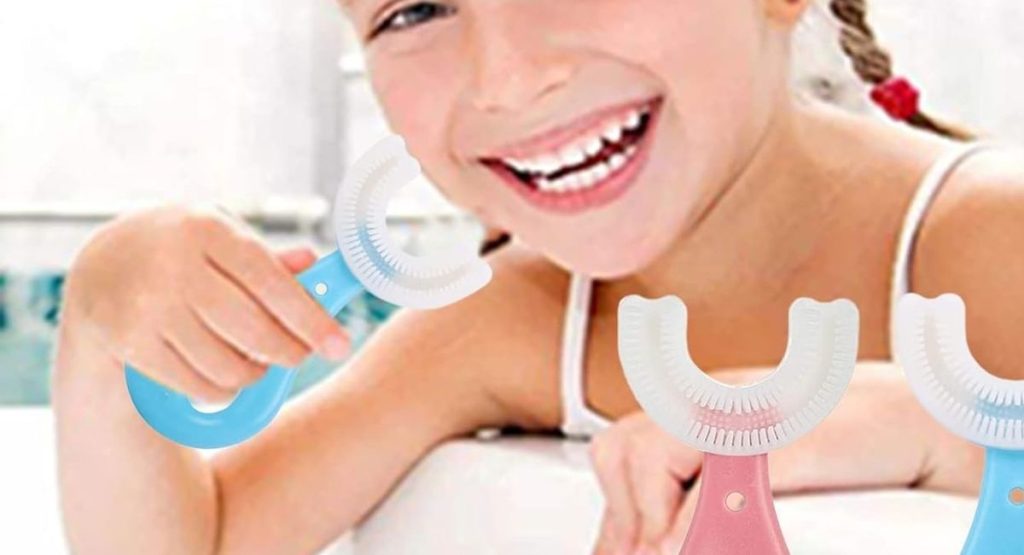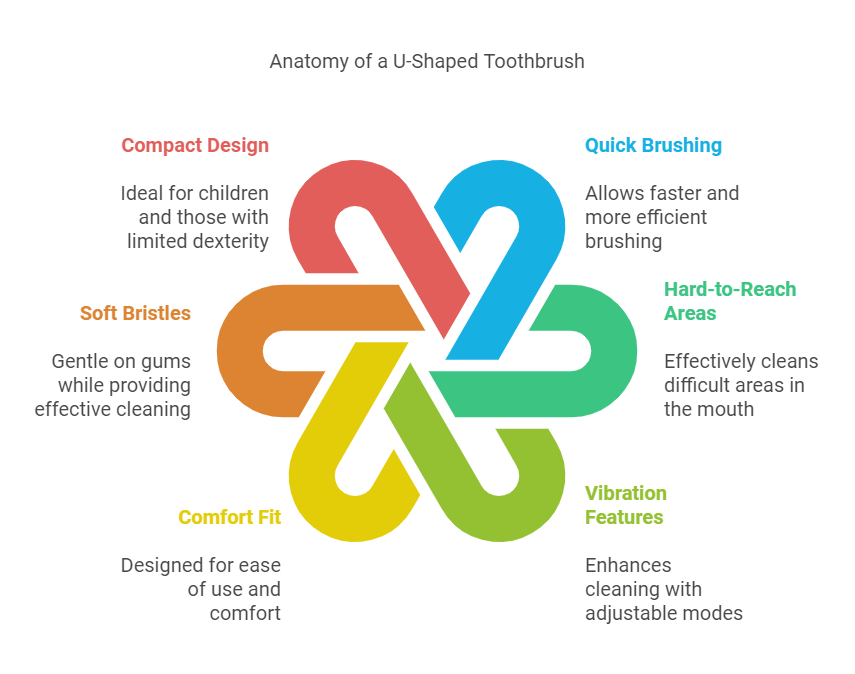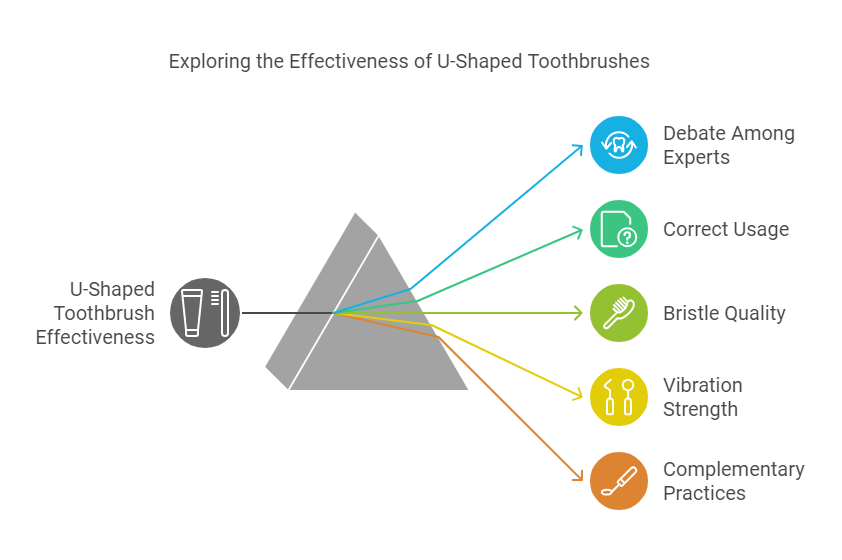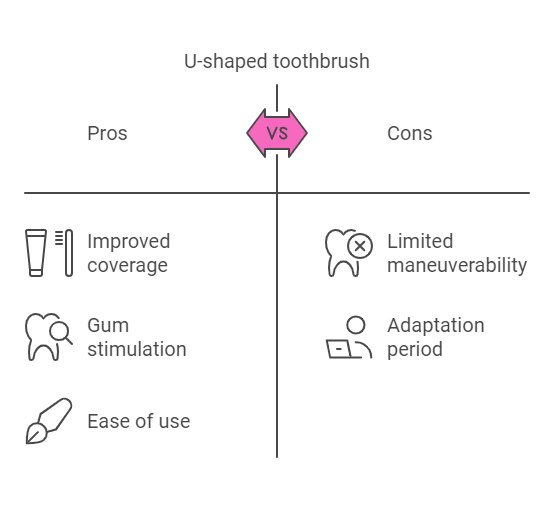As an Amazon Associate. I earn from qualifying purchases
U-shaped toothbrushes are now more popular than before. Their unique shape promises better cleaning for teeth and gums. Many people find them appealing for dental hygiene. But do they truly work? Let’s explore this in detail.

Understanding U-Shaped Toothbrushes
A U-shaped toothbrush looks like the letter “U.” It has bristles on both sides. These bristles aim to clean teeth from all angles at once. The design “hugs” your teeth for a faster brushing experience. It also promises a more thorough clean.
But how do they compare to traditional toothbrushes? Are they a breakthrough in oral care? Or just another short-lived trend? Let’s find out.
How do U-shaped toothbrushes work?

The U-shaped is for quicker and easier brushing. It covers more of your mouth at once, reducing effort and saving time. This design also targets hard-to-reach areas for a thorough clean. Many U-shaped toothbrushes include vibration or pulsation features. These added technologies promise to boost cleaning efficiency.
The U-shaped toothbrush fits your mouth comfortably. Its soft silicone bristles are gentle and protect your gums. Vibrations help remove plaque and dirt better than regular brushing. Many models include adjustable vibration modes for a personalized experience.
The compact design suits kids and those with limited dexterity, making it easier to handle. Built-in timers make sure you brush for the right time. But regular toothbrushes may still be needed for tough spots.
Are U Shaped Toothbrushes Effective?
Experts still debate how well U-shaped toothbrushes work. Some studies say they clean plaque and help gums. Others claim they fall short compared to traditional toothbrushes. The results vary, leaving the debate ongoing.
U-shaped toothbrushes work well if used correctly. They are great for quick, hands-free brushing. However, their performance varies based on bristle quality and vibration strength.

Regular flossing and proper techniques are still crucial for oral health. Experts recommend pairing U-shaped brushes with routine dental checkups. Users should also consider personal needs like sensitivity or orthodontic care.
These toothbrushes are a fine addition, but should not be a substitute for traditional ways.
Pros of U-shaped toothbrushes
Improved Reach and Coverage
- U-shaped toothbrushes cover all tooth surfaces at once, improving efficiency.
- Traditional brushes require more effort to clean every crevice.
- The U-shaped design simplifies brushing, reducing the chances of missed areas.
Enhanced Gum Stimulation
- U-shaped brushes provide more contact with gums, promoting better circulation.
- Helps prevent gum recession by offering consistent gum stimulation.
- May reduce the risk of gingivitis with regular use.
Ease of Use
- U-shaped brushes are easy to use and help people with physical challenges.
- Their design is comfortable to hold and works with one hand.
- This makes brushing simple for many users.
Cons of U-Shaped Toothbrushes
Limited Maneuverability in Tight Spaces
- U-shaped brushes are effective for open-mouth cleaning but struggle in tight areas.
- Difficult to reach the back of the mouth or clean misaligned teeth due to the rigid design.
Adaptation Period for New Users
- Requires adjustment when transitioning from traditional toothbrushes.
- The new technique and sensation may feel unfamiliar, leading to potential frustration.
- Incomplete cleaning may occur during the initial adjustment phase.

Comparison with Traditional Toothbrushes
| Aspect | Traditional Toothbrushes | U-Shaped Toothbrushes |
|---|---|---|
| Effectiveness in Plaque Removal | Highly effective in reducing plaque buildup. | Effectiveness in plaque removal is still unproven. |
| Reliability | Strong dentist recommendations support its reliability. | Fresh approach, lacks substantial evidence for superiority. |
| Gum Health | Basic gum care, benefits depend on technique. | Gently massages gums, potentially improving gum health. |
| Consistency and Technique | Relies on consistent technique for optimal gum health. | Requires consistent use and proper technique for full benefits. |
User Testimonials
What Do Real Users Say?
User reviews show mixed feelings about U-shaped toothbrushes. Some praise their ease of use and improved oral health. Others mention struggles with maneuvering for a thorough clean.
These experiences highlight an important point. No product suits everyone. Personal needs and preferences should guide the decision to try a U-shaped toothbrush.
Conclusion
Should you switch to a U-shaped toothbrush? The answer depends on your needs. These brushes offer unique benefits, but they also have limitations.
Your decision should reflect factors such as size of mouth, positioning of teeth, and any physical limitations. Consulting a dental professional can give you tailored advice to determine what will work best with your oral-care routine.
FAQs
Can children use U-shaped toothbrushes?
Some manufacturers offer smaller versions of U-shaped toothbrushes specifically designed for children. However, it’s always best to consult with a pediatric dentist before introducing a new product into your child’s oral care routine.
Can U-shaped toothbrushes replace regular dental visits?
No, U-shaped toothbrushes are not a replacement for professional dental care. Regular check-ups and cleanings are still necessary for maintaining optimal oral health.
Are there any specific techniques for using a U-shaped toothbrush?
While the design of these brushes allows for more comprehensive coverage, it’s still important to follow proper brushing technique. Make sure to brush for at least two minutes, using gentle circular motions and paying attention to all surfaces of your teeth. Also, replace the brush head every three months or sooner if bristles become frayed or worn.

